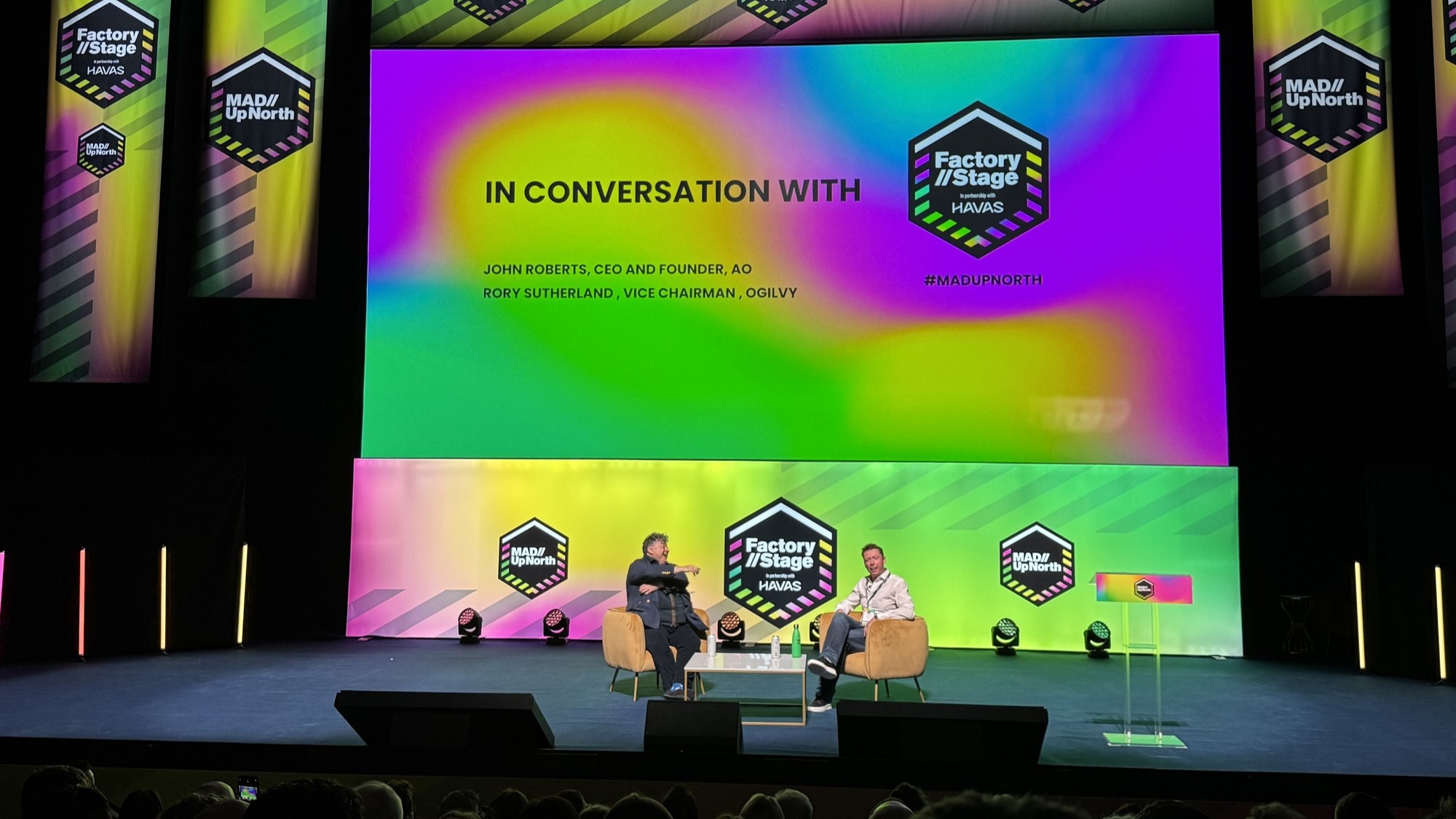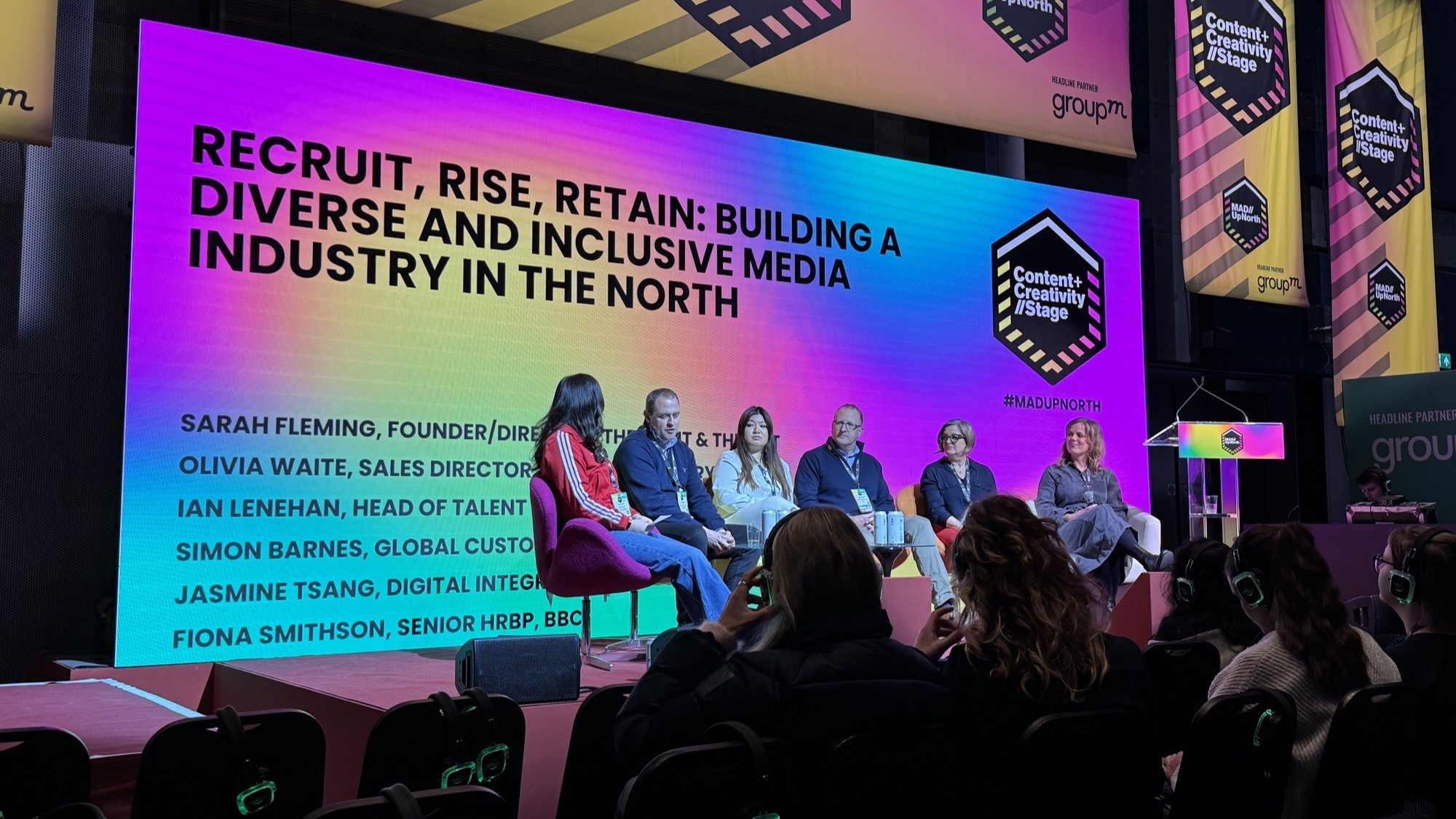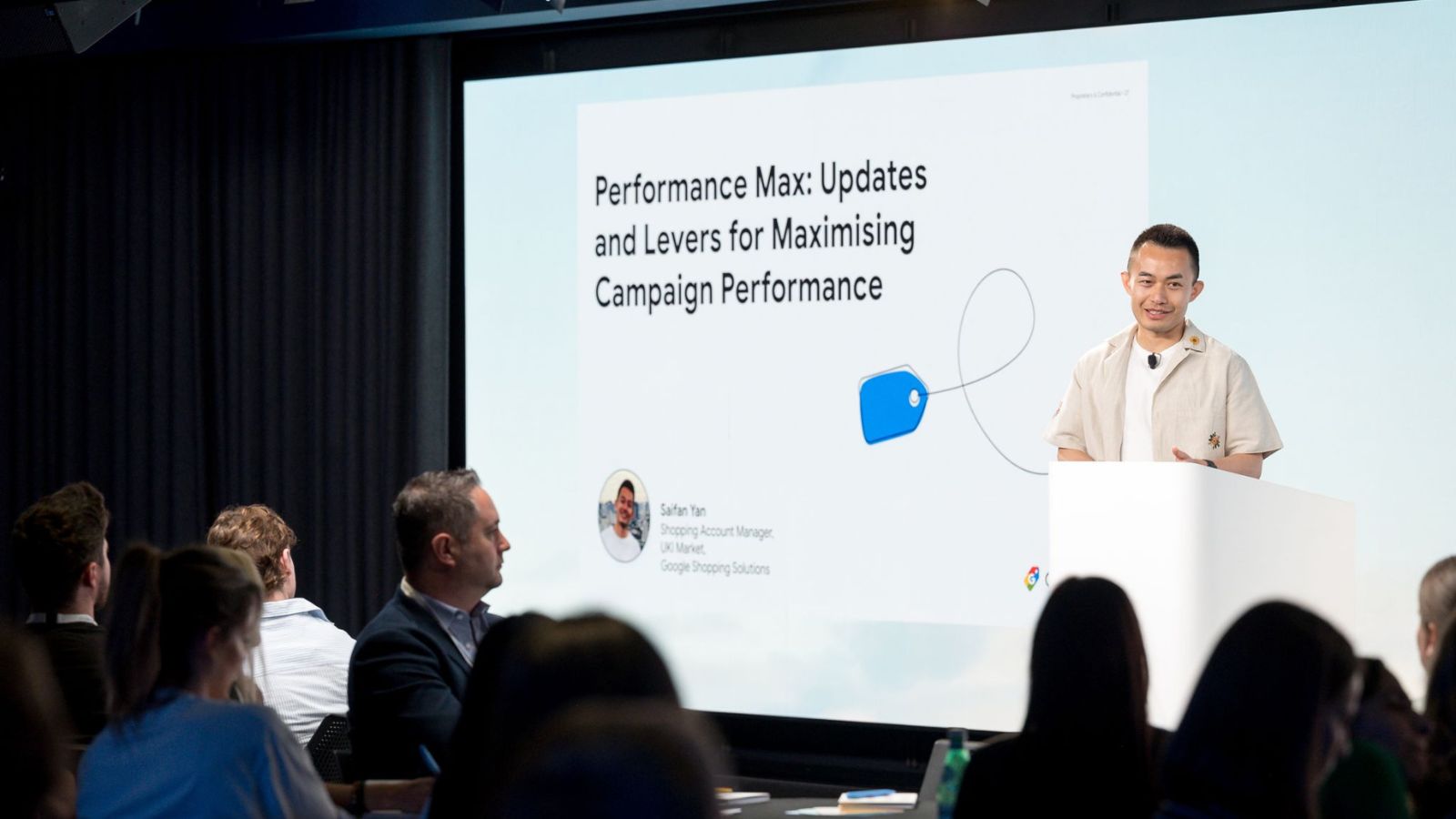MAD Fest brings together iconic brands, disruptors, agencies, publishers, content creators and innovators to make a marketing conference like no other. 2025 marked the first year the festival ventured above the M25, finding a home at Aviva Studios in Manchester. The two-day festival was packed full of insights from regional and global brands, entrepreneurs and northern advocates – and HUB was there to capture everything you might want to know.
Rory Sutherland in conversation with John Roberts, Founder of AO World
For: Brand Managers and Business Owners
The first session of the festival came from marketing master Rory Sutherland and AO founder John Roberts. In it, they discussed how AO came into being, and the power of brand building.
Straight out of the bat, Roberts pushed his signature entrepreneurial mindset by suggesting that going against the curve can be a strategic advantage for some brands. “If everybody says you’re nuts, it’s usually a green light for me,” he said. He continued to champion the power of long-term thinking and staying true to your vision, even when everyone else seems to be playing it safe. He argued that the key to success is building brand affinity and reputation, and highlighted the importance of maintaining brand affinity without excessive reliance on metrics. As an example, he mentioned the complimentary green AO bears which are gifted to customers and have become a hot commodity for collectors. “The day we need to start measuring [the effect of the bears on brand affinity] is the day we should cease business,’ he said.
Roberts also made a strong case for investing in long-term brand-building whenever the budget allows because great brands aren’t built overnight—they take years to develop. He commented that TV advertising is often the first thing marketers stop investing in when looking to save money, because the cost savings are immediate and the impact on brand won’t be felt for a while – but this is a short-sighted mindset and will impact the business in the long run.
He pointed out the unique advantage of founder-led businesses, which typically think beyond quarterly profits and plan for the long haul. This is in stark contrast to the pressures faced by larger corporations, where short-term financial goals often drive decision-making. Roberts also emphasised how company culture can directly influence the customer experience. For example, getting delivery drivers to care about their work may sound simple, but it’s a tough challenge that can make or break a customer’s perception of the brand.
Sutherland jumped on this note, and highlighted the need for marketers to have a voice in every stage of the business to ensure complete personalisation and customer satisfaction. As an example, he proposed giving ecommerce customers a choice of delivery partners rather than allowing procurement teams to prioritise cost-cutting over customer experience. He believes this would offer brands a solution to the 20-30% drop off rate experienced at check-out stage when customers realise the delivery will be handled by a third party they have had a negative experience with.
He expanded upon this to hammer home the point that the most successful and relevant global brands are “marketing brands” like Unilever and Nestlé – brands that focus on customer needs and have marketing-driven strategies that lead to long-term success, rather than prioritising operational efficiency.
Finally, Sutherland looked at how businesses with slower feedback loops can learn from those with rapid cycles, like Amazon, as they have already gone through rigorous rounds of testing to ensure a smooth customer journey. He points out how banks, for instance, could adopt a “call me back” feature which Amazon has already perfected to make getting help easier for customers.
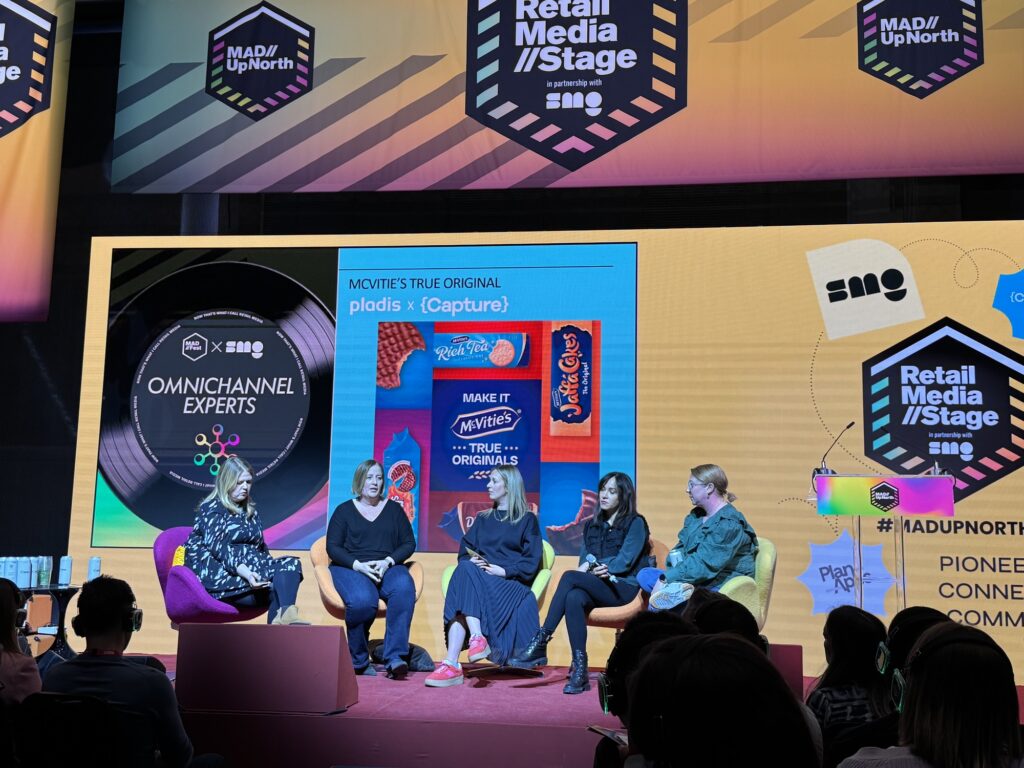
Now That’s What I Call Retail Media: Lessons from the industry’s best
For: Retail Media Marketers and Strategists
Speakers: Gemma Goldfingle (Journalist and Editor); Katie Streeter Hurle (SMG); Alice Anson (Nectar360); Michele Dainty (pladis Global); Nicole Kivel (Criteo)
We’re gonna hold our hands up – we missed a fair bit of this talk, but we did get the insight on the creative, omnichannel and tech trends that will shape retail media strategy in the years to come.
Creative trends
Strong and quality creative will continue to be a key driver of ROI in retail media over the coming years. Consumers are bombarded with content daily, so the best campaigns will need to be relevant and personal to cut through the noise.
Omnichannel trends
In omnichannel strategies, McVitie’s ‘True Original’ campaign showed how campaigns are being transformed by data; this campaign utilised data from Nectar and Clubcard subscribers to ensure McVitie’s targeted the right audience. With this data, in-store journey mapping and impactful creative at key touchpoints (“cardboard still works as an effective channel in stores”), this campaign drove both brand awareness and sales, reaching 11 million impressions and 500,000 engagements across 500 stores.
Looking forward, measurement and attribution tools like multitouch attribution and media mix modelling will be essential for assessing impact across retailers, with an emphasis on determining the impact on the end consumer (“It’s the customer you need to care about, not the touchpoint”). The next challenge is scaling 1:1 customer targeting across channels.
Tech trends
The key trend for retail media in years to come is – you guessed it – the expanding role of AI. Predictive AI is optimising audience creation and campaign planning, while generative AI is enabling personalised campaigns at scale. Smart planning tools will use performance data for more effective campaign optimisation, and real-time insights—like weather or stock levels—will make digital messaging more reactive and relevant.

Turning Customer Insight into Unique Retail Media Opportunities
For: Brand and Retail Media Managers and Strategists
Speakers: Jess Clerke and Ellen Kirk (John Lewis Partnership)
With 21m customers and £13bn in sales last year, John Lewis is one of the top three brands in the UK. How have they built this reputation? Jess Clerke attributed this to a consistency in customer service and communication.
These USPs become even more apparent when Clerke told us that one third of John Lewis’ customers also shop at Waitrose, but this segment contributes to two thirds of John Lewis Partnership’s total sales, meaning this audience is engaged, loyal and trusting of the John Lewis Partnership brand. Clerke explained that this presented an opportunity for cross pollination between the two brands, leveraging the two networks together by aligning the right John Lewis products with the right Waitrose content. She presented pages from Waitrose Food, which showcased John Lewis cookware in its food photography to maximise product awareness across an engaged and relevant audience.
Ellen Kirk then took the audience through how John Lewis leverages its unique position in the mind of UK consumers at Christmas – after all, is it even Christmas until the John Lewis ad is out? She told us that their average customer spends 23% more in John Lewis at Christmas than any other time of year, highlighting the importance of seasonal marketing in John Lewis’ strategy. She played their ‘Snapper: The Perfect Tree’ ad from 2023, showcasing how John Lewis leveraged its brand affinity with suppliers who featured in the ad – Lego and Beats – and expanded the creative beyond the two-minute ad, transforming the assets into a multi-channel journey campaign across 10-second spot adverts and in-store POS for maximum effectiveness.
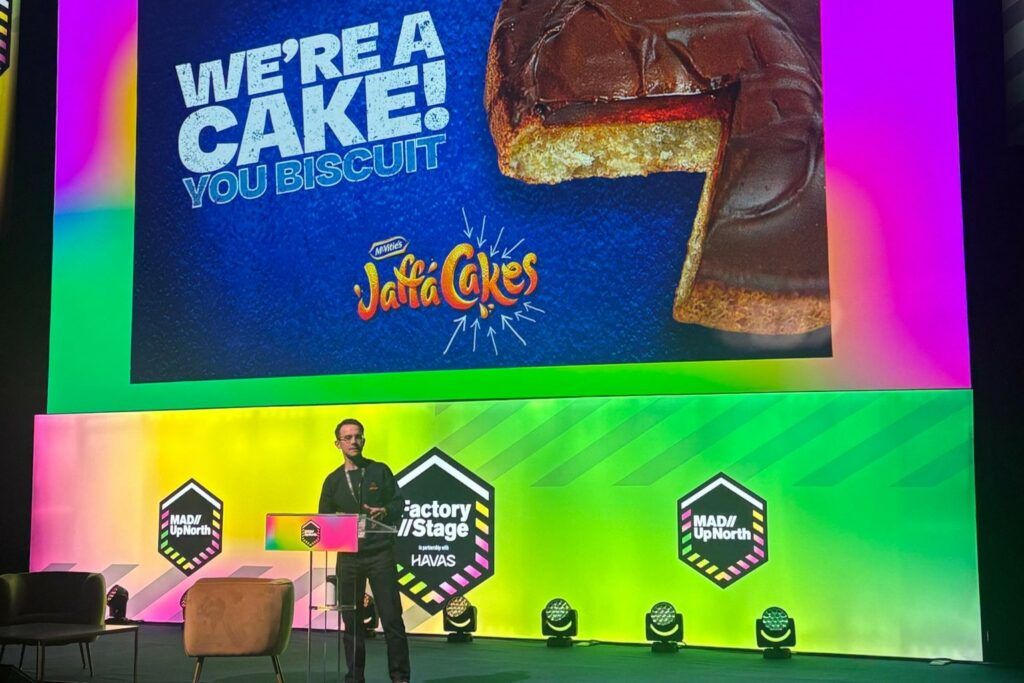
Made In Stockport – The Marketing Magic of Jaffa Cakes
For: Brand, Marketing and Product Managers
Speakers: James King (pladis Global)
Jaffa Cakes is a household name, with an impressive 90% brand awareness—a rare and enviable position for any brand. Yet, despite this strong recognition, sales took a sharp hit between 2021 and 2023, plummeting by 23%. The culprit? A lack of truly memorable advertising.
Jaffa Cakes once had a standout campaign—the iconic “Full Moon, Half Moon, Total Eclipse” is still quoted by Jaffa Cake enjoyers today—but in recent years, nothing had captured public imagination in the same way.
To turn things around, Jaffa Cakes leaned into one of their most debated quirks: the biscuit vs. cake controversy. This, paired with a fresh approach to marketing, helped to reignite audience interest. They tapped into influencer culture and disruptive advertising techniques, even going so far as to ‘vandalize’ billboards with cheeky out-of-home campaigns. New product innovations also played a role, with bold flavours like cola bottle shaking up the range.
The results spoke for themselves. By 2024, Jaffa Cakes saw a 12% rebound in sales, proving that a mix of nostalgia, controversy, and creative marketing can bring even the most established brands back into the spotlight.
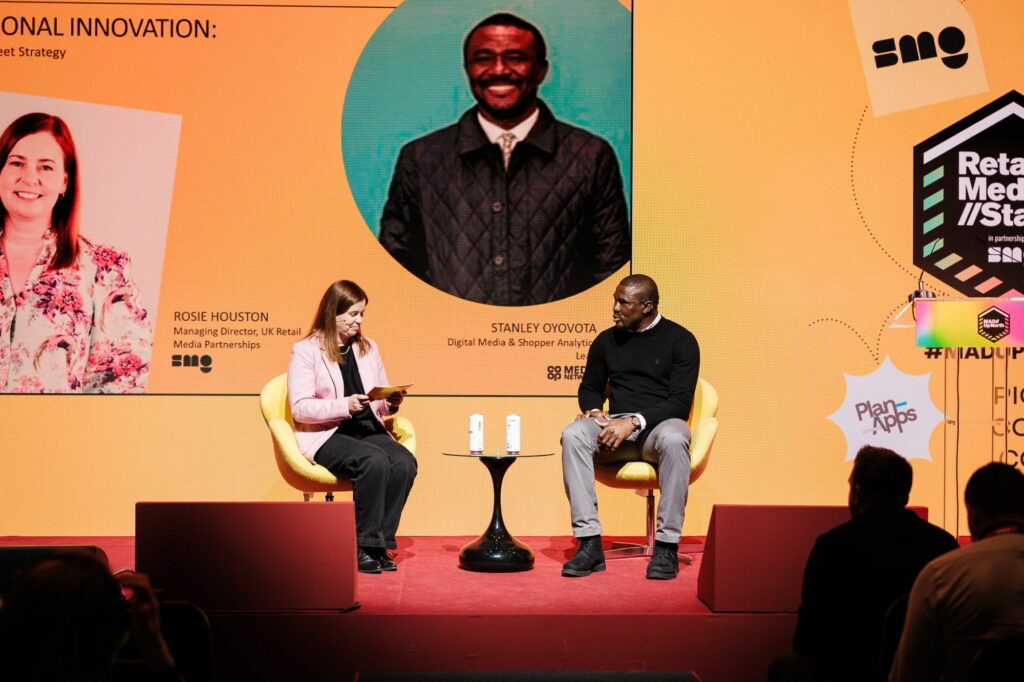
Intentional Innovation: When Ideas Meet Strategy
For: Retail Media Marketers and Strategists
Speakers: Stanley Oyovota (Co-op Media Network)
Did you know the Co-op is the most shopped store in the UK? In this session, Stanley Oyovota of Co-op Media Network took us through his top tips for product and marketing innovation in retail media that have driven this success.
He stressed that internal resource and preparedness is key for ensuring your innovation has a stable foundation, and that the best strategies will always tie back to the brands’ mission, vision and values.
He also emphasised the need to put the audience first when embarking on an innovative project or product launch. After all, audience precedes channel in every other strategy – why should this be different for innovation? Here, he outlined the importance of audience segmentation to drive effectiveness.
Oyovota then went on to share his top tips for minimising risk when tackling an innovation project. Stress testing the campaign with trusted customers and suppliers before execution is key according to Oyovota, and nurturing a constant feedback loop will ensure your data is accurate throughout the process.
When it comes to measuring innovation beyond commercial ROI, Oyovota encourages marketers to ask these three questions:
– Does it drive a genuinely competitive advantage?
– Does it improve the customer experience?
– Does it drive brand loyalty?
If so, you might be onto a winner!
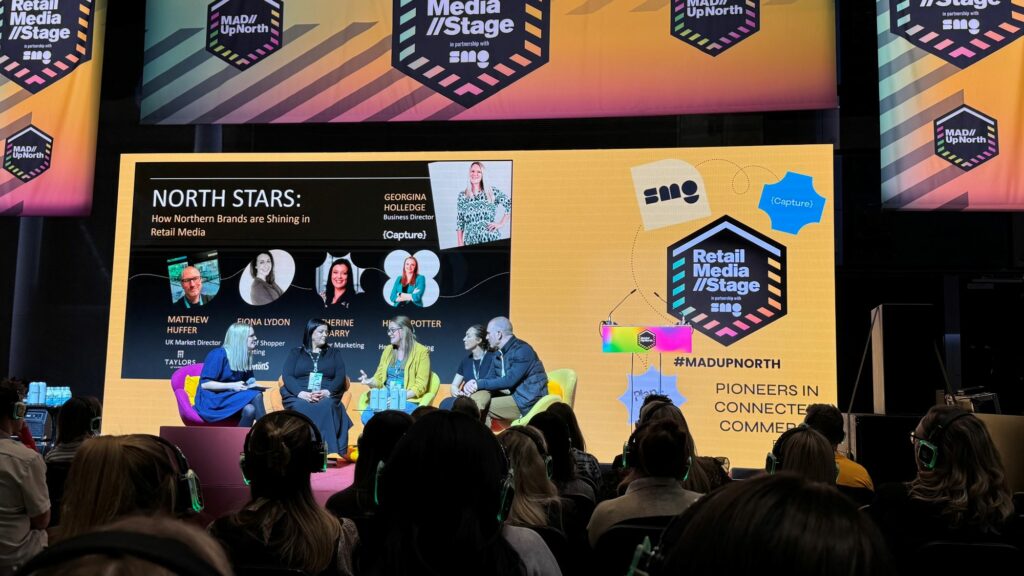
North Stars: How Northern Brands are Shining in Retail Media
For: Brand and Retail Media Managers and Strategists
Speakers: Fiona Lydon (Warburtons); Matthew Huffer (Taylors of Harrogate); Georgina Holledge (SMG); Catherine McGarry (AGBarr); Helen Potter (Kelloggs brands, Kellanova)
This session brought together a handful of northern retail brands who are on top of their game to discuss innovation, creativity, data and changing landscape of retail media.
Planning & Innovation
Helen Potter emphasised the importance of early planning, even saying that a recent Kellogg’s campaign took a whopping 18 months to plan. Brands are also pushing the boundaries of retail media, expanding its scope and impact beyond traditional formats to explore new opportunities.
Evolving Retail Media Landscape
The retail media landscape is evolving rapidly, with a growing focus on omnichannel mixes rather than a reliance on standalone retail media. Investments in screens and Connected TV (CTV) is becoming increasingly important for brands and retailers looking to maintain and grow market share. When it comes to how retailers can address challenges in implementing large-scale campaigns, Fiona Lyndon argued that brands must implement correct test-and-control measures from campaign conception, establish category benchmarks for correct campaign evaluation, correct inaccurate post-campaign reports, and ensure compliance and executional integrity.
Creativity in Retail Media
Creative execution, once primarily dominant in Above The Line (ATL) marketing, is now playing a growing role in retail media. Matthew Huffer used Taylor’s of Harrogate’s ‘Flying Start’ breakfast coffee bags and ‘Rich Italian’ afternoon coffee bags as an example of how the brand swapped their digital creative during the day to align with product focus, demonstrating the power of creative flexibility with digital assets.
The Role of Data in Decision-Making
Data is a game-changer in retail media, enhancing decision-making by providing comparable insights across various marketing mix elements. Potter noted that this leveraging of data increased confidence among senior leaders at Kellogg’s. Her Cheez-It case study showed that 50% of brand-building investment in Below The Line (BTL) tactics matched the awareness generated by the brand’s ATL campaign, maximizing impact through consistent creative execution.
Integrating Retail Media in the Marketing Mix
Lyndon stressed that ATL and BTL strategies must work together, despite their different objectives. ATL drives brand fame, while BTL retail media is more immediate, reactionary, and highly targeted. A protein product campaign, for example, adapted messages for customers at different stages of the sales funnel and used various touchpoints like digital six-sheet placements for broad reach and store-proximity targeting.
Future Trends in Retail Media
When asked what the next 12 months in retail media looks like, the panel was optimistic about the opportunities available to retailers and brands alike. There was a consensus that retail media is poised to outpace traditional media, with growing competition between outlets. Lyndon predicted that AI will drive the expansion of retail networks and media channels, while customer loyalty programs will continue to evolve.
Potter highlighted the “Power of 3” — aligning brand, supplier, and customer to drive business performance. Catherine McGarry also noted creative execution as being a continuing key to success. Although 60% of retail media’s success is already attributed to quality creative, she predicts that AI playing a crucial role in optimising the personalisation and relevancy of campaign creative.
Oldie but a Goodie – How to Modernise a 180-year-old business
For: Brand and Marketing Managers
Speakers: Kenyatte Nelson (Co-op)
Brands don’t belong to businesses, they belong to the customers, argued Kanyatte Nelson. He believes there’s no such thing as a “brand guardian” because no single entity controls how people perceive a brand. Instead of obsessing over rigid guidelines, companies should focus on listening, adapting, and delivering experiences that resonate with their audience. A brand lives in the minds of the people who engage with it, not in a rulebook.
When it comes to creative work, constraints aren’t the enemy—they’re the secret weapon, said Nelson. A tight, well-thought-out brief doesn’t limit creativity; it fuels it. The clearer the direction, the more room there is for bold, strategic ideas to flourish. Without boundaries, creativity can spiral into chaos, but with the right focus, it turns into something powerful and effective.
In fiercely competitive markets, Nelson also argued that the smartest move is to get more people to buy what you already have. The “same stuff, more people” approach has been a game-changer for Co-op. Instead of constantly chasing new product ideas, focus on converting customers from rival brands. If your product is great, there’s no reason someone loyal to a competitor wouldn’t make the switch – show them why they should.
Speaking of switching, nothing drives conversion like getting your product into people’s hands. Trial campaigns work because they break down hesitation and let customers experience the value first-hand. A well-placed promo, a free sample, or a limited-time offer can be the nudge someone needs to leave their old brand loyalty behind and choose yours instead.
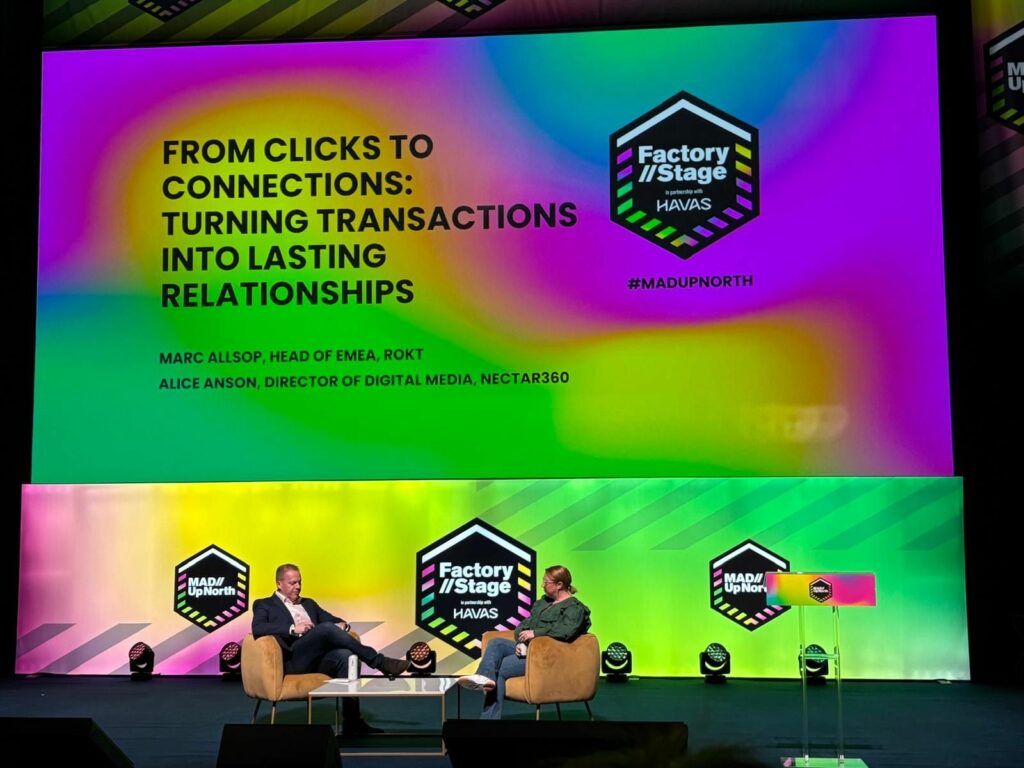
From Clicks to Connections: Turning Transactions into Lasting Relationships
For: Performance and Brand Marketers, Operations
Speakers: Marc Allsop (ROKT) and Alice Anson (Nectar360)
In this session, Marc Allsop and Alice Anson took us through their top tips on using data to not only convert customers but keep them.
According to Allsop and Anson, trust isn’t just important—it’s everything. Free customers put their full trust in one brand, and once they do, they rarely look elsewhere. Earning that trust takes more than just good marketing; it takes consistency, value, and experience.
Want better ideas? Walk the customer journey yourself. Seeing firsthand what works—and what doesn’t—sparks insights no report can. The best solutions come from experience, not assumption.
One key outtake of this session was that tech investment isn’t optional: it’s survival. Brands that fail are the ones that fall behind. Whether it’s AI, seamless UX, or data-driven decisions, staying ahead is the only way to stay in the game. Speed also matters. A website weighed down by a backlog of changes loses customers. The ability to tweak, update, and adapt in real time is a game-changer for retention.
Ignoring data is also a death trap, according to these two. Companies that don’t track, sort, and use their data properly miss critical opportunities. Data is power—only if you use it.
And, finally, no matter how advanced technology gets, they say nothing beats in-person collaboration. The energy, the quick ideas, the creative breakthroughs—no screen can replicate the magic of a room full of people bouncing ideas off each other.
